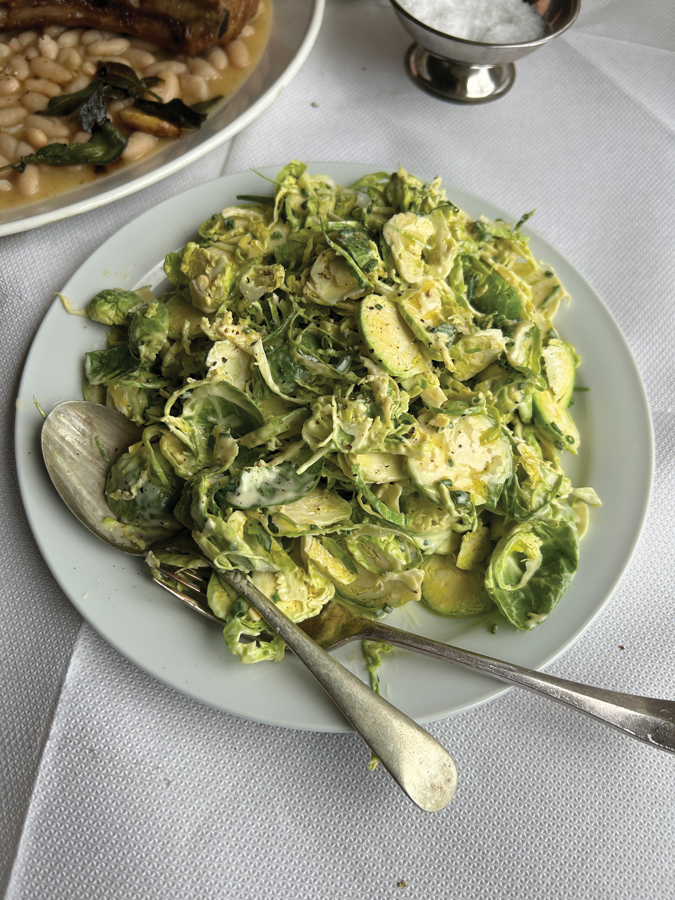These recipes are perfect for using leftover sprouts or when you can’t face turkey anymore …
After my trip to Paris, I want everything to be served with a side of celeriac remoulade. Although this may not be the wisest choice health-wise … This recipe produces beautifully rendered, crispy fat on the pork chops, similiar to how you’d cook duck or chicken thighs. Starting with a cold pan is key to rendering the fat down slowly for the best flavour and texture. @kittycoles
Serves 2-4
Ingredients
2 large bone-in pork chops
Fine salt and freshly ground black pepper
1 tbsp vegetable oil (if needed)
1 tbsp salted butter
2 garlic cloves, crushed
A few sprigs of fresh sage
1 jar of white beans, with their liquid
Extra virgin olive oil
Juice of half a lemon
For optional crispy skin (Ed Smith’s method): If the pork chop has the rind on, carefully slice it off, leaving the fat on the edge of the chop. Heat the oven to 240°C (220°C fan). Sprinkle a generous amount of salt over the skin and place it skin-side up in a small baking dish. Roast for 15-20 minutes until golden, puffed and crunchy.
Method
1. Prepare the pork chops: Pat the pork chops dry and season generously with fine salt and black pepper at least 10 minutes before cooking. If you’ve seasoned in advance and the chops have moisture on them, just pat them dry again.
2. Render the fat: Place the pork chops upright, fat side down, in a cold, heavy-based frying pan. Set the heat to low and let the fat render slowly for about 5–7 minutes. This slow rendering process brings out the flavour and gives you a beautiful golden fat edge. Tilt the chops occasionally to ensure even rendering.
3. Sear the pork chops: Once the fat is golden, remove the chops from the pan, turn up the heat to medium-high, and add a bit of oil if needed. When the oil is hot, return the pork chops to the pan, laying them flat. Sear the chops for about 4 minutes on each side until deeply golden. Once done, remove from the pan and let them rest.
4. Crispy sage: Turn the heat to medium and add the butter to the pan. Once melted, add the garlic and sage leaves, frying until the sage is crisp and the garlic aromatic, about 1 minute. Spoon this over the resting pork chops.
5. Warm the beans: Add the beans, with their juices, to the pan along with a splash of water. Cook for a few minutes until bubbling, then mash a few beans with the back of a fork to thicken. Drizzle in some extra virgin olive oil and squeeze in the lemon juice. Season to taste.
6. Serve: Slice the pork chops off the bone and cut into thick slices. Spoon the beans onto a serving plate, layer the pork slices on top, and serve with remoulade and extra mustard on the side if desired.

Brussels Sprout Remoulade
You can scale this recipe up or down, as you want. Be sure to cook as many pork chops as you’ll need and then adjust the amount of sprouts accordingly. You can also substitute the sprouts for blanched green beans, thinly sliced white cabbage or cucumber.
Serves 2-4
Ingredients
400g Brussels sprouts
1 lemon, juice
4 heaped tbsp mayonnaise
2 heaped tbsp crème fraîche
1 tbsp Dijon mustard
25g parsley, chopped
Method
1. Trim the bottoms off the sprouts, discard any damaged outer leaves and cut them in half. Shred the sprouts in a food processor – you can use a grater attachment if you have one, but it’s not essential, or you can slice them finely.
2. Tip into a large bowl, pour over the lemon juice and give the sprouts a good toss with your hands to combine.
3. Mix together the mayonaise, crème fraîche and mustard with some seasoning. Just before serving, tip into the bowl with the sprouts, along with the parsley. Mix well and season to taste.
Make your own mayonnaise
Ingredients
1 egg yolk
1 tsp Dijon mustard
1 tsp white wine, apple cider vinegar
Pinch of sea salt
75 ml extra virgin olive oil
150ml vegetable oil
Lemon juice, to taste
A few grinds of freshly ground black pepper
Method
1. Put the egg yolk, mustard, vinegar, salt into a bowl, then place the bowl on a dish towel, so it doesn’t slip around when whisking. Combine the two oils in a jug.
2. Whisk the egg mix vigorously until pale, then drizzle in the oil very slowly until the mixture starts to emulsify and thicken. Keep adding the oil until you have a thick-looking mayonnaise.
3. Squeeze in the lemon juice and check for seasoning, adjusting as necessary.






